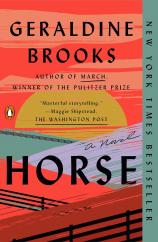Reading Group Guide
Discussion Questions
Horse

1. On page 28 (Theo, Georgetown, Washington, DC, 2019), Theo reflects that depictions of horses are among the oldest art humans created. The book’s epigraphs reflect on the significance of Lexington --- in his day, an even bigger celebrity than Seabiscuit or Secretariat. Discuss the enduring human fascination with horses. Do they move you more than other animals? If so, why?
2. Theo and Jess are both obsessed with their rarefied fields of expertise. Does the author manage to convey why these unusual careers can be so compelling? If so, how?
3. Jarret’s connection with horses is presented as stronger than his bonds with people. How does his love for and dedication to Lexington help or hamper his coming of age and his transformation over the course of the novel?
4. Horseracing in the mid-19th century was very different to its modern iteration. What surprised you? Do you think horseracing today takes adequate care for the well-being of equines?
5. On p. 71 (Thomas J. Scott, The Meadows, Lexington, Kentucky, 1852), Scott writes, “[We] who think we are above enslaving our fellow man are corrupted. Only show us absolute agency over the apt and the willing, and suddenly we find the planters’ obduracy that much less odious. I must guard against the rank seductions of this place.” How does the author draw out the similarities and differences between Northern and Southern attitudes in this era through Thomas J. Scott, a practiced observer who moves between the regions?
6. Several historical figures appear in the novel, among them the emancipationist newspaper publisher Cassius Clay and his daughter, the suffragist Mary Barr Clay. What are Cassius Clay’s arguments for emancipation to the Warfield family? Do you see the roots of what would become Mary Barr Clay’s passion for the women’s suffrage movement in the way she is portrayed in her youth? What are their respective strengths and limitations? How do novels make historical figures come alive for us beyond what we might find in a work of nonfiction?
7. Martha Jackson was a real American gallery owner and art collector. Discuss her portrayal in HORSE and what her relationship to the painting of Lexington conveys about her character. What does her storyline contribute to the novel’s themes? What did her chapters reveal to you about America in that era, and did you notice any similarities between the art world of the mid-20th century and the horse racing economy of a century prior?
8. Referring to the Civil War on p. 87 (Jess, Smithsonian Museum of Natural History, Washington, DC, 2019), Jess says, “Not my war […] Unless you call Australia the very Deep South.” Theo is also not American. Nevertheless, they’re both forced to reckon with the legacy of slavery --- particularly Theo, who encounters racism in his daily life. How does this affect their relationship? What does the novel reveal about the way history shapes our present moment?
9. Discuss Theo and Jess’ relationship. What do you think attracts them to one another despite their differences? What do they learn from each other?
10. Examine Jess’ conversation with Daniel in the aftermath of what happens to Theo at the end of the novel. What did you make of Daniel’s assessment of the situation? Do you share his point of view?
Horse
- Publication Date: January 16, 2024
- Genres: Fiction, Historical Fiction
- Paperback: 464 pages
- Publisher: Penguin Books
- ISBN-10: 0399562974
- ISBN-13: 9780399562976







